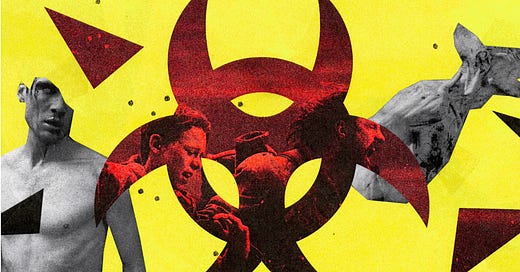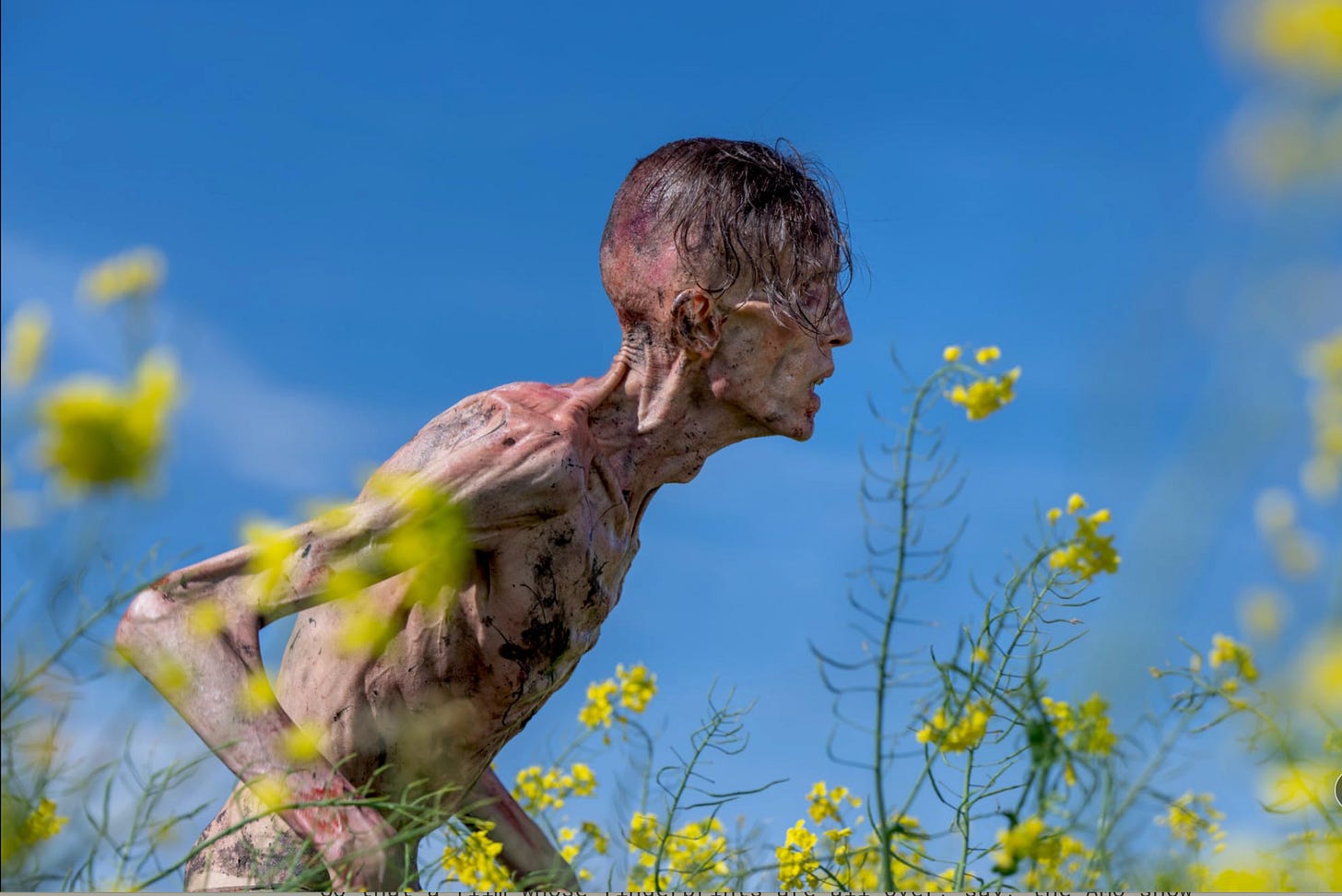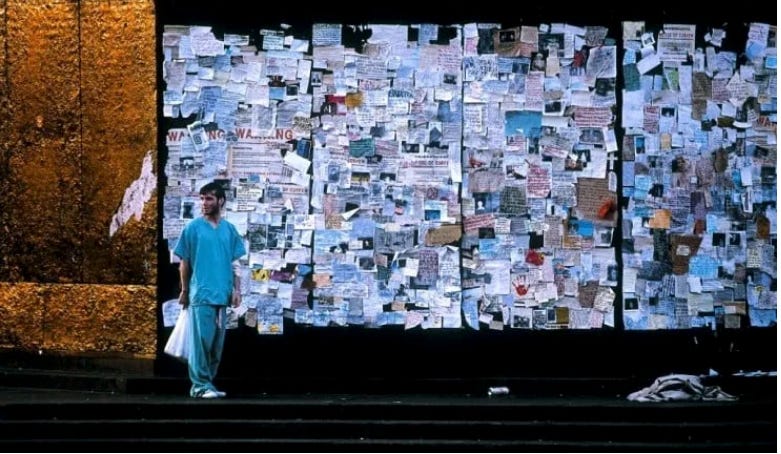28 Days and Years Later
The original filmmakers reunite for a sequel to their landmark 2002 zombie apocalypse film "28 Days Later" — a reflection of what's become of us

“The crisis consists precisely in the fact that the old is dying and the new cannot be born,” begins the quote whereby Antonio Gramsci went posthumously viral in the Trump age: “In this interregnum, a great variety of morbid symptoms appear.” Might these include retching, staggering, spitting blood, and murderously chasing after fellow humans? Does this make the political philosopher’s “Prison Notebooks” yet another potential origin of the modern zombie apocalypse?
Such are the half-cracked suspicions that emerge if you spend any time considering the impact and meaning of the brainy, visceral, resoundingly punk-rock film 28 Days Later and its new sequel 28 Years Later. Which I did a piece in this week’s New York Times Magazine, for a Screenland column that takes a relatively narrow slice of the zombie landmass, and was a blast to deliver.
What follows are some DVD extras for the piece, with additional thoughts from the filmmakers.
Like many Gen-Xers I’m a child of the Zombie Age, born near the release date of George A. Romero’s Night of the Living Dead, and raised in the golden age of American horror: Halloween, The Shining, Alien, Poltergeist — the whole post-Easy Riders, Raging Bulls era of big, swinging auteur horror. These films were released against a counterpoint of Romero’s own low-budget sequels — Dawn of the Dead, Day of the Dead, Land of the Dead, several more — and, when it came out in 2002, 28 Days Later somehow fit into both traditions.
Today, the film also sits alongside other liberal-minded, early-’00s dystopian art-films like Alfonso Cuarón’s Children of Men in a kind of microgenre (the “cozy apocalypse”?), into which I’d also place 2018’s underrated The Night Eats the World (set in a Saint-Germain-des-Prés block in Paris’s 6th arrondissement), Jarmusch’s 2019 Romero homage Dead Don’t Die, and HBO’s melancholic “The Last of Us,” (which 28 Days screenwriter Alex Garland in a podcast with “Last of Us” director Neil Druckmann, called “better than 28 Days” — generously and, imho, inaccurately).
All these works seem deeply informed by conventions of a genre that can almost seem like a form of its own. And in the case of Night of the Living Dead and 28 Days Later, a form with eerie resonance with real life events.
When I spoke with Romero in the late-‘00s, he’d self-exiled to Toronto, partially due to an early blow to his fortunes that can only be called Biblical. Due to a copyright filing error, Night of the Living Dead — which the Library of Congress had deemed “culturally, historically, or aesthetically significant,” and which spawned everything from its countless Hollywood knock-offs to Public Enemy’s “Night of the Living Baseheads” — didn’t earn its writer and director a penny for most of his life.
In an odd if less punishing echo to this, copyright issues also kept 28 Days Later off streaming platforms until late last year. So that a film whose fingerprints are all over, say, the AMC show “The Walking Dead” couldn’t be seen by those same viewers during its run. But like Night of the Living Dead, the film’s cultural impact was such that it almost didn’t need to.
So convincingly did 28 Days reboot the entire subgenre that Romero, a purist who’d half-jokingly insisted that zombies must move slowly and inexorably, gave the racing marauders of 28 Days Later an admiring pass on a technicality: “Because they’re not zombies,” he told me with a smile. “They’re ‘infected.’”
When I spoke to Alex Garland and Danny Boyle over Zoom a few weeks ago, I was struck by the warm fuzzy feeling that surrounds their horrific enterprise. The team that assembled to make 28 Days Later 24-odd years ago brought such high spirits and innovative filmmaking to this classic 20th century story of society consumed by rampaging inhuman monsters that this mid-budget horror film launched enviable careers for most everyone involved.
For Boyle, it was his first homerun as a major director. He endorsed the idea that one’s first film is always one’s best. “I think that's absolutely true,” Boyle said. “Because you don't really know what you're doing.”
Later comes the technique that can warp or redirects creative impulses into the more traditional shapes the form exerts on its adepts and professionals. This is the punk ethos in a nutshell, and something both Boyle and Garland said they sought to preserve.
“The first film was made with a lot of innocence,” Garland said. “It certainly was for me, because it was the first film I'd ever worked on. So inevitably it had a naivete and something punk about the attitude. And if you lose the punk, then the films sort of, conceptually, don’t exist.”
Boyle’s first movie was the fine, low-budget black-comedy crime film Shallow Grave, and his second, The Beach, was received primarily as a Leonardo DiCaprio vehicle. Garland wrote the novel that The Beach was based on and, in hanging out on location during principal photography, realized how much more fun movie making was than writing fiction — at least when the director is Danny Boyle.
My impression was that Boyle and Garland speak often, about everything, and have over so many years that 28 Years Later is a product not only of the skills each independently developed over two decades, but of their friendship over this time.
They said they’d postponed considering this film until they felt they could recapture some of the original film’s “innocence” — an interesting word choice for a film about mortification of the flesh and soul. But 28 Years Later is palpably a product of the same rough, fast, WTF style of innovation that produced the original film, and updates its bravura use of cheap digital video cameras by shooting the new film entirely on iPhones.
“The thinking behind it was to actually embrace the basic technology that's available,” Boyle told me. “Rather than a lot of the way that the industry is going, moving towards exquisite, elite IMAX quality thresholds, premium prices, all that kind of stuff. It’s a struggle I have with cinematographers. I always look to try and make it imperfect. I try and crack it, split it, damage it somehow.” He also used the technology with a kind of moral intention. “We wanted the violence when it hit you, to hurt you,” Boyle said.
Like 28 Days Later, the new film speaks to the fraught moment at which it arrives, which is the central topic of my NYTM piece. But there’s something about these particular films’ resonance with key historic moments of real-life horror that will stay with me forever.
Everyone has their own 9/11 story. I was picking my kids up when I walked by a TV…. I was in history class when our teacher came in and said…
Mine begins: I was near the base of the Twin Towers, taking photos and wondering how the spectacle would play out…. And it ends with a moving-image sequence I’ve tried and failed to describe a thousand times, ever since it burned into my retinas and those of everyone on the street that morning, and revealed a new truth.
Boyle’s is just as indelible: I was in London beginning principal photography for a film about a disaster that spreads murderous psychosis across the land.
Twenty-four years later, that film seems like something more than a kick-ass horror movie. More than even a smart and soulful one. It’s something more like an egregore, an autonomous entity with its own power, an emergent Jungian archetype. The shots of missing-person fliers filling kiosks in an empty Piccadilly Circus were inspired by similar fliers that appeared in China after an earthquake. “But the film got released,” Boyle said. “And the film changed.”
Similar changes may come with 28 Years Later, which I advise the brave to see. Once again, the film arrives at a moment of flux, months after an avatar of the real-life digital rage virus made its way into the White House, where it now spits blood and swipes at enemies, lurching from victim to victim. An earlier draft of the NYTM piece ended with a life-imitates-art observation that I’ll close with here:
Recently, the White House deactivated the websites “covid19.gov” and “covid19tests.gov” to link to an official page that resembles the movie poster for a low-budget ’90s geopolitical thriller, “Lab Leak: The True Origins of Covid-19,” against whose block letters the figure of Donald Trump walks Sorkin-ishly towards the viewer. Below which, scrolling bullet points present five false, debunked, or irrelevant claims about the virus before stopping at an image straight from the expository opening of a War on Terror thriller.
It’s a shimmering monochrome aerial map of China, with “Wuhan Institute of Virology” and “Huanan Seafood Market” appearing as if tube stops on London’s Piccadilly line: too close not to be fatefully linked, too foreign not to be suspicious. The whole thing mentally quarantined, like England in 28 Years Later, and thus no longer our problem.





